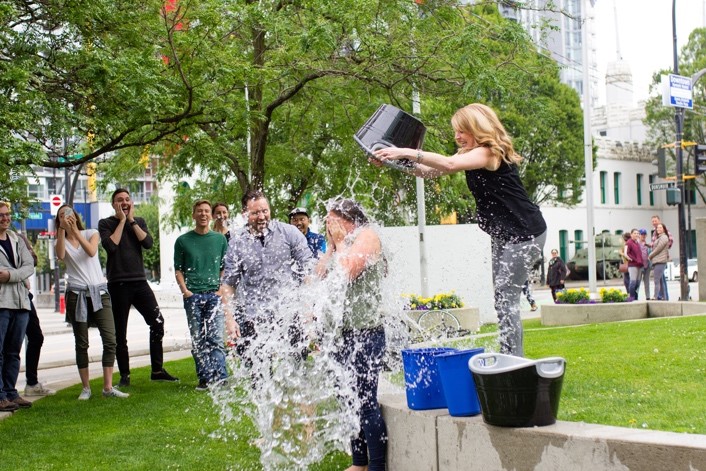 ALS Ice Bucket Challenge in Vancouver - Photo Credit: Unsplash.com
ALS Ice Bucket Challenge in Vancouver - Photo Credit: Unsplash.comBy Andrea S. Peterson, CMP, MTA | Faculty, Metropolitan State University of Denver
With hotels, sports and performing arts, and restaurants and bars among the top 10 industries hardest hit by the pandemic, it is no surprise that shut-downs and stay-at-home orders dramatically impacted non-profits who rely on these industries for their fundraising efforts. Indeed, 2020 was a year fraught with a necessity for creativity in this arena, as organisations scrambled to find alternative ways to fund their programmes and operating needs. The old saying necessity is the mother of invention reigns supreme, we all learned, in that many groups figured out how to fundraise quite effectively in a virtual world.
The Big Brothers Big Sisters of the Bluegrass USA had to find an alternative to their annual Bowl for Kids’ Sake fundraiser and did so via a unique scavenger hunt. The hybrid event involved the “creation of small teams to fundraise leading up to the event and then participate in the scavenger hunt on the designated day. Participants could choose to attend the in-person event with their team or participate virtually. This option opened up fundraising opportunities for those uncomfortable with attending in-person events. The best part? Virtual attendees were given equal opportunity to compete for prizes in the scavenger hunt” (qgiv.com, Lessman, 2021). This process points to the success of peer-to-peer fundraising, seeding the campaign with healthy doses of competition and then recognising the most successful fundraisers at the end of the challenge. Because peer-to-peer fundraising taps into supporters’ existing networks and trusted relationships, it is extremely effective in a virtual world as the craved connections lead to fostering successful campaigns.
 ALS Ice Bucket Challenge in Vancouver - Photo Credit: Unsplash.com
ALS Ice Bucket Challenge in Vancouver - Photo Credit: Unsplash.com
Thankfully, technological advancements have served to facilitate organisations’ needed pivots. Quick adopters have found text-to-give campaigns a lifesaver, with social media campaigns allowing groups to rapidly advertise and garner new followers in the process. During the pandemic, TikTok became the new kid on the block, assisting organisations by facilitating hashtag challenges. “TikTok will often take it one step further and make their own donation for every video posted with a specific charity-related hashtag” (wildapricot.com, Izmailova, 2021). Combining these two technologies yielded successful returns for the American Heart Association, who made it easy for supporters to fundraise by providing text-to-donate instructions over social media posts in their ‘Keep the Beat’ challenge. This challenge “created a unique social media campaign perfect for the dance-focused [TikTok] app. Supporters were encouraged to create videos of them moving to ‘Keep the Beat’ in honor of the American Heart Association and to raise money and awareness in honor of American Heart Month in February” (mobilecause.com, Baker, 2021). Popular shopping platforms such as Amazon have also become huge supporters of non-profits. Amazon’s “Smile” programme allows shoppers to choose a charity of choice to benefit. By registering an organisation and encouraging a simple URL change to smile.amazon.com, millions of dollars have been awarded globally to non-profits through shoppers’ purchases where Amazon donates 0.5% of each purchase.
In the same vein, many caring businesses have opted to partner with organisations in donating proceeds to various causes, and benefactors have been tapped for matching programmes, making focused email fundraising campaigns a viable option.
Yes, standard galas and silent auctions can now be live-streamed or delivered completely virtually, with fully online silent auctions, thanks to a plethora of platforms developed of late. However, perhaps the most interesting option of all is the “un-gala” concept. Placing emphasis on staying at home, not spending money on a new outfit and transportation, and instead making the largest donation possible to a cause – this alternative to the fancy gala fundraiser, if messaged appropriately, can yield significant returns.
About Andrea
Andrea Peterson has been a faculty member for the event and meeting management courses at Metropolitan State University (MSU) of Denver since 2013. She holds a Bachelor’s Degree in Business Management from LeTourneau University and a Master’s Degree in Tourism Administration, with a concentration in Events & Meetings Management, from The George Washington University. She achieved the Certified Meeting Professional (CMP) designation in 2011 and served as a member of the Events Industry Council’s Industry Insights Committee during 2019 and is currently a member of EIC’s Knowledge Committee.
She is the founder and CEO/President of ASAP - As Strategic As Possible Meetings & Events - in Castle Rock, Colorado, a boutique planning company she originally established in Texas in 2009. She and her associates assist select corporate and non-profit clients in crafting meetings and events to specifically meet their strategic goals.
Andrea previously served as Operations & Events Manager of the Royal Bank of Canada’s (RBC) USA Real Estate Mortgage Capital business and was also formerly the Events Coordinator in Marketing for the North America Lending Division of General Electric’s Commercial Finance Real Estate.
Cited References
Baker, S. (2021). 5 Nonprofits and How They’re Using TikTok to Fundraise. MobileCause. Retrieved from https://www.mobilecause.com/5-inspiring-nonprofits-that-are-using-tiktok-to-fundraise-success/.
Izmailova, S. (2021, May 10). 25 Online Fundraising Ideas Perfect for Any Cause (Social Distancing Approved!). Wild Apricot. Retrieved from https://www.wildapricot.com/blog/online-fundraising#4-social-media-challenge.
Lessman, S. (2021). Bright Idea: Hybrid Scavenger Hunt Fundraiser. Qgiv.com. Retrieved from https://www.qgiv.com/blog/scavenger-hunt-fundraiser/.
Events Industry Council